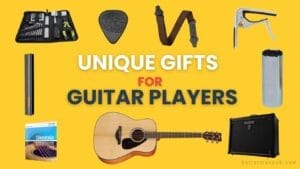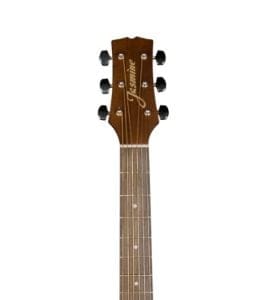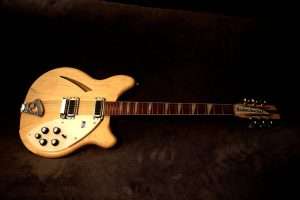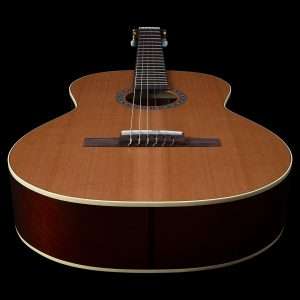Table of Contents
Unique Guitar Models You’re Missing Out On Knowing About
Unique guitars have been mainly created to discover various dimensions and innovations. There’s never a lack of space for unique guitars in the music world. It’s where innovation, craftsmanship, and audacious creativity have given birth to various unique and extraordinary instruments.
So, strap in and get ready to explore the 9 most unique guitar designs that are as visually stunning as they are sonically spectacular.
Before that, don’t forget to check out our list of the best budget acoustic guitars.
Chimera By Emerald Guitars
The Emerald Guitars Chimera is a remarkable instrument that seamlessly fuses innovation with tradition. The history of this exquisite guitar can be traced back to the company’s founding in 1999 by Alistair Hay.
Emerald Guitars embarked on a mission to redefine how guitars were made, employing cutting-edge carbon fiber technology that revolutionized the industry.
The Chimera model, in particular, has evolved into a pinnacle of Emerald’s craftsmanship, blending the rich heritage of acoustic guitar design with the resilience of carbon fiber materials, delivering a distinctive, beautiful, and environmentally-conscious instrument.

Features of The Chimera
| Body Shape | Grand Auditorium |
Body Type | Double Neck |
String number | 18 (12 strings in one neck, 6 in another) |
Top Material | Carbon Fiber (Vibrant Weave) |
| Back and Sides Material | Carbon Fiber |
Neck Material | Carbon Fiber |
| Electronics | Graphtech Ghost Piezo |
| Tuners | Gotoh 510 tuners 18:1 ratio (Chrome) |
The Chimera Is Ideal For
- Environment-conscious musicians seeking performance and sustainability.
- Guitarists looking for lightweight double-neck bodies.
Synergy x20 By Emerald Guitars
Another unique model from a custom carbon fiber Guitar, the Synergy X20, is not a pure guitar. It’s called a harp guitar. It has one traditional guitar neck and another curved one that works as a harp with six set strings and no frets.
The harp guitar was invented in the 17th century but only rose to prominence in the 20th century. The Synergy X20 is the perfect instrument for playing sustained bass notes on the harp while fingering the guitar.

The Features of The Synergy x20
Color | Red |
| Carbon Type | Standard Weave |
| Veneer | None |
Tuners | Gotoh 510 tuners 18:1 ratio (Black) |
| Inlays | None |
| Pickup | Graphtech Ghost Piezo |
| Bridge Type | Carbon Bridge Fully Adjustable for Height and Intonation |
| Weight | 6.75lbs, 3kg |
The Synergy x20 Is Ideal For
Guitarists who play pieces with a complex arrangement that has sustained bass notes
Guitarists who love the attention that comes with weird and unique guitars
Solace By Emerald Guitars
In 2020, the world was in lockdown. Meanwhile, Alistair Hay, the founder of Emerald Guitars, tried his hand at designing the very first Emerald Acoustic Lap Steel Slide Guitar.
It was a welcome distraction and inspiration during a difficult time, so he named it Solace. Now refined and improved, Solace is available for performers looking for a sleek slide guitar to glide on.
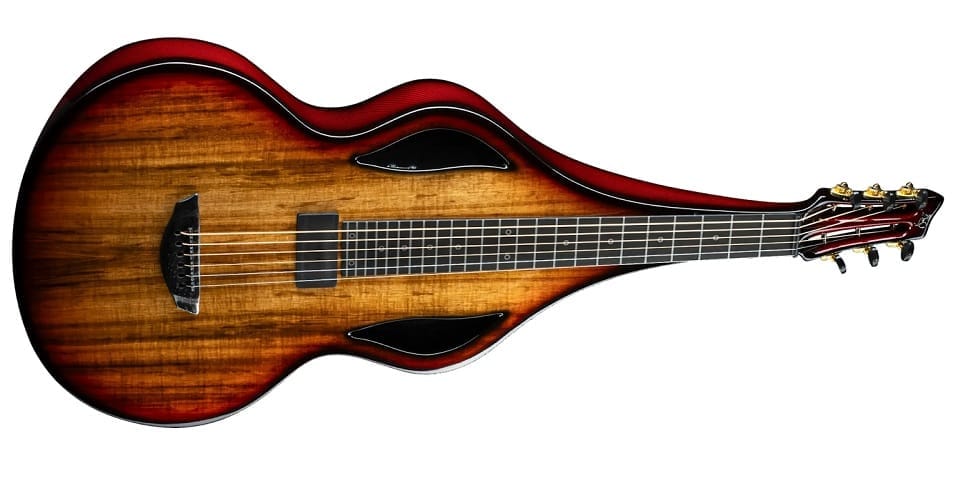
Features of The Solace
| Color | Red |
| Finish | High gloss finish on all surfaces |
| Scale Length | 25 and 1/2″, 648mm |
| Frets | 24 medium stainless steel |
| Nut Width | 43mm |
| Carbon Type | Vibrant Weave |
| Veneer | Royal Ebony |
| Tuners | Gotoh 510 tuners 18:1 ratio (Gold) |
The Solace Is Ideal For
- Guitarists who play the lap steel guitar a lot and travel a lot
- Guitarists looking for an environment-friendly slide guitar
Click here to learn everything about 12-string guitar strings!
La Baye 2×4 Standard By Eastwood Guitars
The Eastwood La Baye 2×4 Standard is a unique guitar model produced by Eastwood Guitars. It is a modern reinterpretation of Dave Bunker’s classic ’60s La Baye design.
This distinctive and weird guitar showcases a combination of retro aesthetics and modern functionality. The La Baye 2×4 Standard is a head-turner known for its striking minimalist rectangular body shape and unconventional appearance.

Features of the La Baye 2×4 Standard
| Body | Basswood |
| Neck | Maple, Bolt-on |
| Fingerboard | Rosewood, Dot Markers |
| Scale Length | 24 3/4″ |
| Width at Nut | 1 5/8″ |
| Pickups | Dual EW Custom Hi-Output P-90s, Chrome Covers |
| Switching | 3-Way |
| Bridge | Tune-o-matic, Stop Tail. Les |
The La Baye 2×4 Standard Is Ideal For
- Guitarists who play long gigs standing upright.
- Guitarists who primarily shape their tone digitally do not require a full-sized body for tone.
The 3-string Shovel guitar
The ‘Justin Johnson Signature’ 3-String Shovel Guitar is a model inspired by the design showcased in Justin Johnson’s viral video, “Crankin’ Up the 3-String Shovel Guitar.” Justin Johnson individually handcrafts each of these unique instruments.
He meticulously handles the soldering, string action adjustment, and thorough testing to guarantee strength, dependability, outstanding tone, and comfortable playability. Justin selects all the parts and components of these guitars to ensure you find the hardest-hitting shovel.

Features of The 3-string Shovel guitar
| Pickup | Justin Johnson Signature Hand-Wound electric pickup |
| Manufacturing | Made by hand and individually numbered |
| Hardware | Chrome |
| Volume Knob | Included |
| Tuners | High-quality enclosed tuners. |
| Output jack | Standard quarter inch. |
| Compatible with | standard guitar gear (cables, amplifier, straps) |
| Fret markers | Burnt into the wooden handle |
The 3-string Shovel guitar Is Ideal for
- Guitarists looking for gear that can be used both for playing riffs and beating people up
- Guitarists who do farming when they’re not playing gigs
Little Crow Guitars Justin Johnson Signature Resonator Guitar
The Little Crow Guitars Justin Johnson Signature Resonator Guitar is a remarkable electric guitar designed and championed by the talented musician Justin Johnson. As an innovative and renowned guitar maker, Johnson has created this unique guitar to cater to professional musicians and enthusiasts.
This model has an interesting circular resonator plate in the middle of the body. The resonator chamber shapes the tone into something unique to the Little Crow.
Hey, click here if you are looking for electric guitars that fit your budget!

Find Similar Resonator Guitars at Amazon,
Features of the Little Crow Guitars Justin Johnson Signature Resonator Guitar
| Body | Silver Quandong from Queensland, AUS |
| Neck | Queensland Maple |
| Fretboard | Ovangkol |
| Electric Pickup | Seymour Duncan P-Rails pickup with Triple Shot Mount |
| Tailpiece | Body-Mounted Fixed Bar |
| Strings | Curt Mangan nickel wound 12-54 |
| Nut | Graph Tech Tusq XL nut |
| String Spacing | nut 36mm, bridge 52.5mm |
The Little Crow Guitars Justin Johnson Signature Resonator Guitar Is Ideal for
- Guitarists who play lead but want natural reverb and resonance in their tone
- Blues, jazz, soul, etc. guitarists
Misa Kitara By Misa Digital
The Misa Kitara is a revolutionary and futuristic instrument that blurs the lines between traditional stringed instruments and modern technology. The Kitara is a digital guitar-like instrument that takes a unique approach to music creation and performance.
The instrument features a large touchscreen interface that replaces traditional strings and frets. Musicians can tap, slide, and press on the touchscreen to create different notes and effects, similar to playing a guitar.
The Kitara offers an extensive range of sounds, from classic guitar tones to synthesizers, drums, and other digital effects. This versatility makes it suitable for various music genres, including rock, electronic, and experimental.
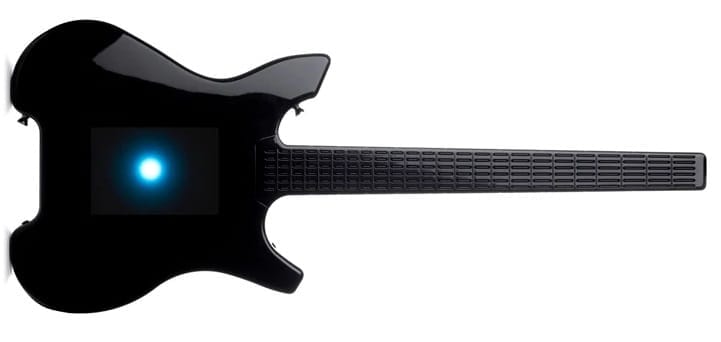
Features of the Misa Kitara
| Controller | MIDI |
| Fretboard & Body | Touchscreen |
| Fret | 24 |
The Misa Kitara Is Ideal for
- Guitarists who want to play a MIDI controller but can’t play keys
- Guitarist dabbling in electronic music
Djentar x Stevie T 20 String Guitar
The Stevie T 20-string guitar was a one-off model explicitly made for the YouTuber. This was born after Stevie T’s Djent War with Jared Dines in 2019.
The guitar features 20 strings and covers every gauge and note in the universe. Tuning this takes an eternity, too. You can play everything on that monstrous fretboard, from piercing leads to booming bass.
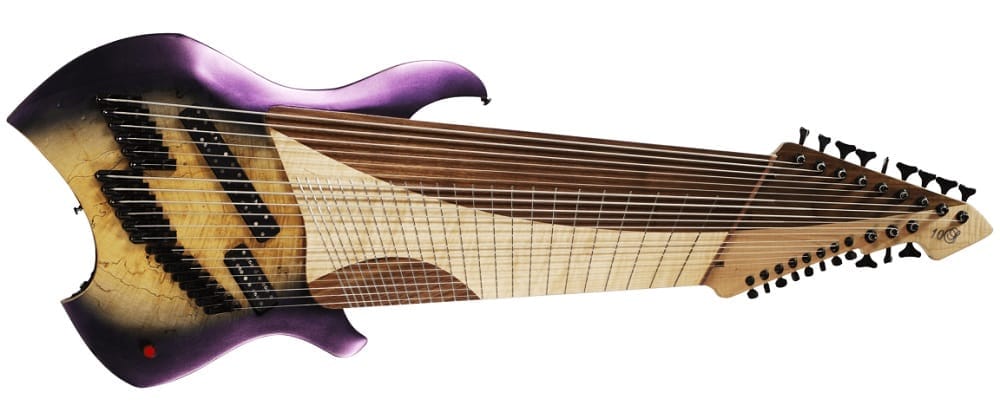
Features of the Djentar x Stevie T 20 String Guitar
| Finish | Chameleon to Natural |
| Body | One Piece Black Walnut Body |
| Top | Flame / Spalted Maple |
| Neck | 9 Piece Flame Maple & Rosewood |
| Fretboard | 3 Piece Flame Maple / Rosewood |
| Pickups | 4seasons Handwound |
The Djentar x Stevie T 20 String Guitar Is Ideal for
- Stevie T
- Anyone with screws loose enough, fingers long enough, and pockets deep enough to custom order another of these.
Filip Skelecaster
YouTuber Prince Midnight created a unique guitar named the “Filip Skelecaster” with a body made from his late uncle’s human skeleton.
Initially, his uncle’s remains were in a cemetery. Prince Midnight decided to repatriate the bones and transform them into a playable guitar to honor his uncle’s influence and love for heavy metal music.
The instrument’s construction proved challenging, but the result is a playable guitar with some quirks, such as the need to strum within the rib cage.
Prince Midnight sees the project as a way to pay tribute to his uncle’s life and influence, allowing him to “shred for all eternity” in a metal form. This probably takes the prize for being the most unique guitar out there.

Features of the Filip Skelecaster
| Body | Uncle Filip’s ribcage |
| Top | Uncle Filip’s pelvic bones |
| Fretboard & Neck | Stratocaster |
| Pickup | Single coil |
| Compatible with | Standard jacks |
The Filip Skelecaster Is Ideal for
- Uncle Filip’s niece
If you are looking for some cool guitar straps, click here! We have a list just for you!
Apollo Premier
Glass guitars cater to a discerning and tasteful audience. They’re exotic and distinctive and represent an otherworldly level of craftsmanship. Many desire these unique guitars, yet only a select few possess them.
Designed to evoke the essence of the golden age of rock and roll, the Apollo Premier from Morningstar Guitars showcases a classic single-cutaway body. This standardized model is fitted with modern features like pickups and hardware.
With its timeless mirrored back and sleek top adorned by Seymour Duncan JB humbucking pickups, this elegantly crafted guitar offers exceptional visual appeal and tonal experience.
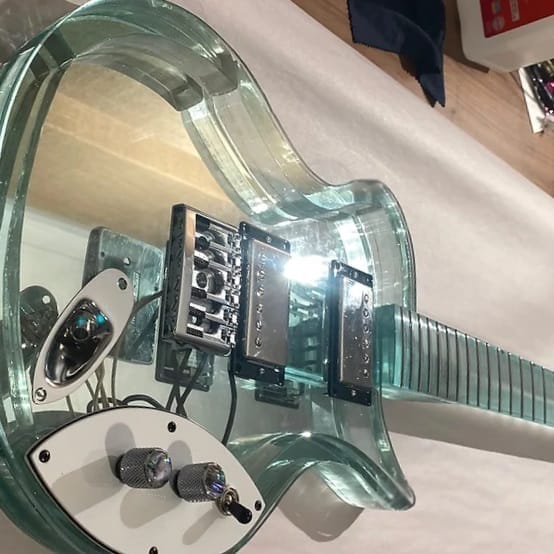
Features of the Apollo Premier
| Strap locks | Grover Quick-Release Strap Locks |
| Tuners | Grover Mini Rotomatics 205 series |
| Nut material | Bone |
| Width at nut | 1.75” |
| Pickups | Seymour Duncan Brand |
| Pickup Selector | 3-way toggle |
| Frets | 22 stainless steel |
The Apollo Premier Is Ideal for
- Adding to your guitar collection display
- Staring at its beauty instead of playing
The Benefits Of Unique Guitars Explained
Extended-range guitars have gained popularity in recent years, offering a range of benefits that cater to modern musicians’ evolving needs and preferences. These guitars typically feature more strings and unique scale lengths, providing several advantages to players. Some are:
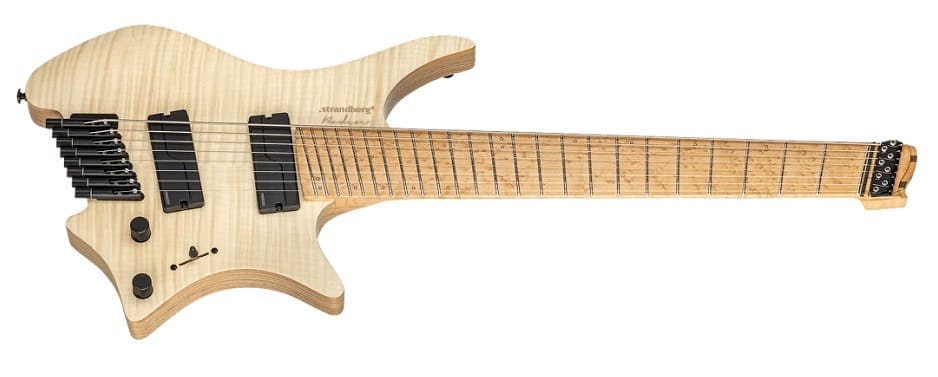
Expanded Range
As the name suggests, extended-range guitars provide an expanded tonal range due to their additional strings. Extended-range instruments can have seven, eight, or even more. This allows players to access lower bass and treble notes, opening up new creative possibilities.
Versatility
The extended range of these guitars lets musicians experiment with different tunings, offering a broader palette of tonal possibilities. This versatility particularly appeals to progressive metal, jazz, and fusion players and those interested in experimental and avant-garde music.
Enhanced Low-End Power
With additional low strings, extended-range guitars provide a more robust and defined low-end. This is especially beneficial for heavy genres like metal and djent, where tight and aggressive soft tones are essential.
Improved Soloing and Chord Voicings
Extended-range guitars allow for more complex and extended soloing patterns. The extra strings can enable guitarists to experiment with unique chord voicings, harmonies, and polyphonic textures that may not be achievable on a standard six-string guitar.
Better Intonation and String Tension
Many extended-range guitars feature a multi-scale design, meaning the scale length varies across the strings. This results in improved intonation and balanced string tension.
Creativity and Innovation
These guitars encourage players to think outside the box and push the boundaries of their playing style. Forward-thinking musicians often use them to create new sounds and compositions.
Unique Aesthetics
The distinctive appearance of extended-range guitars, with their extra tuning pegs, can add a unique visual element to a musician’s stage presence.
Tailored Options
Many guitar manufacturers offer a wide range of extended-range models, allowing players to select instruments that match their specific preferences regarding string count, scale length, body style, and other features.
Accessibility
While extended-range guitars were once considered niche instruments, they have become more accessible and affordable in recent years. Musicians on a budget can now explore these instruments without breaking the bank.
Learning and Skill Development
Playing an extended-range guitar lets guitarists explore more complex chord structures and scales.
Why Do People Play Double-Neck Guitars?

Double-neck guitars, which feature two necks and sets of strings on a single body, are versatile instruments that offer a range of practical and creative benefits. People play double-neck guitars for several reasons:
Expanded Range
The most apparent advantage of a double-neck guitar is the expanded tonal range. Each neck can have a different tuning or set of strings, allowing the player to switch between them instantly.
This expanded range is particularly beneficial for live performances where a guitarist may need to cover multiple guitar parts without switching instruments.
Convenience
Double-neck guitars provide convenience by eliminating the need to switch guitars during a song or performance. For instance, a guitarist might use one neck for rhythm parts and the other for solos.
Tonal Variety
With different necks set up for various tunings, string configurations, or pickups, double-neck guitars offer a wide range of tonal options within a single instrument. This appeals to musicians experimenting with multiple sounds and textures within a single song.
Expressive and Creative Playing
Double-neck guitars encourage creativity and innovation. Musicians can combine and layer sounds from both necks, creating unique compositions and textures you can’t with a single-neck guitar. This fosters experimentation.
Signature Tunes and Iconic Songs
Some musicians use double-neck guitars to replicate iconic guitar parts in live performances. For example, Jimmy Page of Led Zeppelin is well-known for using a double-neck guitar to perform “Stairway to Heaven.” One neck is for the 6-string parts, and the other is for the 12-string sections.
Visual Impact
The unique appearance of a double-neck guitar can add visual appeal to a performance. The instrument’s distinctiveness draws the audience’s attention, making it a compelling choice for stage presence.
Challenges and Mastery
Playing a double-neck guitar requires more skill, coordination, and dexterity. Managing two necks simultaneously can be a rewarding challenge for advanced guitarists.
Niche Music Genres
Some genres of music, such as progressive rock, fusion, and experimental music, benefit from double-neck guitars’ unique capabilities. These instruments enable musicians to explore complex chord progressions and arrangements.
Versatility
Double-neck guitars come in various configurations, such as 6-string/12-string, 6-string/bass, or even more unconventional pairings. These configurations allow players to experiment with different musical styles and instrumentation.
Natural Vs. Digitally Induced Reverb And Resonance

Reverb and resonance are two acoustic phenomena that significantly impact the sound of musical instruments and audio recordings. They can occur naturally in physical environments or be digitally induced through technology.
Here’s an explanation of natural vs. digitally induced reverb and resonance:
Natural Reverb
Natural reverb refers to the reflection and scattering of sound waves in a physical environment. When sound is produced in a space, it bounces off walls, floors, and other surfaces, creating a complex reflection pattern that produces a sense of space or ambiance.
The reverb characteristics of a space depend on its size, shape, materials, and acoustic properties.
Natural Resonance
Natural resonance is the tendency of an object or material to vibrate sympathetically when exposed to sound waves at specific frequencies. When an object resonates, it amplifies and sustains particular frequencies, creating a characteristic tone.
Resonance can be observed in musical instruments when a string, column of air, or other part of the instrument vibrates in response to an energy input. The resulting resonance contributes to the instrument’s unique timbre or tone color.
Digital Reverb
Digitally induced reverb is created using electronic or software-based effects processors. These tools simulate the reverb characteristics of different physical spaces, allowing the addition of artificial ambiance to recordings or live performances.
Digital reverb can be precisely controlled in terms of reverb time, room size, and the character of reflections. It is commonly used to adjust the perceived spatial qualities of audio, adding a sense of depth or spaciousness.
Digital Resonance
Digitally induced resonance can be created through synthesizers, digital audio processors, or software instruments. Musicians and producers can program or manipulate resonance to emphasize or shape specific frequencies, creating unique timbres and textures.
Digital resonance can be highly versatile and experimental, allowing for the creation of entirely new and artificial sounds. Musicians can design resonant effects that wouldn’t occur naturally in acoustic instruments.
Key Differences
- Control: Digital reverb and resonance offer precise control over parameters, while natural occurrences depend on the acoustic properties of physical spaces or instruments.
- Repeatability: Digitally induced effects are repeatable and consistent, while natural reverb and resonance can vary from one space or instrument to another.
- Creativity: Digital effects provide vast creative possibilities, allowing musicians and audio engineers to design unique soundscapes and textures that may not exist naturally.
On Midi Controllers And Why They’re A Nightmare For Guitarists
Guitarists often find playing MIDI controllers shaped like keyboards challenging for several reasons, primarily due to the fundamental differences in playing techniques and instrument design between guitars and keyboards. Here’s why:
Instrument Shape and Layout
Guitars and MIDI keyboard controllers have drastically different shapes and layouts. Guitars have a fretboard with strings, while keyboard controllers have a set of keys.
Guitarists are accustomed to navigating frets, strings, and finger positions, whereas keyboard controllers use keys and a linear layout. This stark contrast in physical design can be disorienting for guitarists.
Playing Technique
Guitarists primarily create sounds by fingerpicking, strumming, bending, and sliding. In contrast, keyboard controllers require pressing keys with the fingers.
The transition from plucking and strumming strings to pressing keys can be challenging. It involves an entirely different set of motor skills.

Expression and Dynamics
Guitars offer expressive techniques such as vibrato, palm muting, and bending notes. These techniques allow guitarists to shape the dynamics and articulation of their playing.
Keyboard controllers do not replicate these techniques similarly, making it challenging for guitarists to convey their intended emotions.
Visual Feedback
The visual feedback provided by a guitar’s fretboard is integral to the guitarist’s understanding of the instrument. They can see the placement of their fingers on the frets and visualize scales and chords.
Keyboard controllers lack this tactile and visual reference, making it more difficult for guitarists to transpose their knowledge of the fretboard onto the keys.
Chord and Scale Shapes
Guitarists often learn chord and scale shapes specific to the guitar’s fretboard. Translating these shapes to a keyboard layout can be cumbersome, requiring relearning or adapting these patterns to the linear key arrangement.
Polyphony and Sustain
Guitars can sustain notes through techniques like fingerpicking or sustain pedals. MIDI keyboard controllers typically sustain notes through key press duration, which may require a different approach to achieve the desired sustain and polyphony.
Lack of Haptic Feedback
Guitars offer haptic feedback through string tension, frets, and the instrument’s feel. Keyboard controllers lack this tactile feedback, making it harder for guitarists to connect with the instrument.
While it’s tempting to go for unique guitars that attract every eye and leave an impression due to their sheer weirdness, you should also consider their utility. The guitar is for you only if its quirks serve your playstyle. Though, if you’re a collector, that’s another case.
Conclusion
And there you have it—the tour of the most unique guitar designs that promised to blow your mind, and hopefully, it did just that. For those looking for a superb guitar, this blog is where you find it. These aren’t just instruments but innovations, each with flair and story. As we wrap up, let’s carry the inspiration from these extraordinary creations into our music and lives. Who knows what amazing designs the future holds? Keep strumming, dreaming, and looking for the next piece that might change how we think about guitars.
FAQs of Unique Guitar
The “Reach Out to Asia” Fender Stratocaster became the most expensive guitar ever in 2005 when it fetched $2,700,000 (£2,232,000) in a charity auction in Qatar.
The 1959 Gibson Les Paul has become one of the most hard-to-attain guitars today. It is heralded as having a perfect balance of construction, woods used, and vintage electronics and flavor.
The Fender Stratocaster holds the title of being perhaps the most famous guitar, widely used by iconic musicians from Jimi Hendrix to Mark Knopfler.
The electric guitar’s uniqueness lies in its capability for amplification. This allows for a range of sonic effects like distortion, giving it a versatile sound palette not achievable with an acoustic guitar.
- 6 Unique Guitar Picks That Will Blow Your Mind - February 6, 2025
- Master the Harmonic Major Scale And Intervals - February 6, 2025
- 9 Eye Catchy Unique Guitar Straps for Every Musician - February 6, 2025




